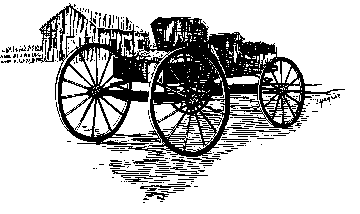The story of the Flat Rock community actually begins in eastern Pennsylvania, where Jacob Albright’s followers began a movement that became the Evangelical Association. The Albright People, as they were named in 1803, organized themselves into classes. One of those was the Thomas Class in McClure, Pennsylvania, many of whose members were converted by Jacob Albright himself.
Most of the Thomas Class emigrated as a group to Ohio, where in 1841 they founded the town of Flat Rock as an Evangelical community. One of their first tasks was to build a church, known as the Old Stone Church, which hosted the Evangelical Association’s General Conference ten years later in 1851, as well as the organizing meetings of the Indiana and Pittsburgh annual conferences.
Delegates to the conferences stayed in the home of Daniel Wonder and his family, built in 1836 before the town was organized. This home was the original site of the Flat Rock class meetings, and Daniel Wonder eventually became a circuit riding preacher in Ohio.
In 1848 another church was built; the Detterman Log Church today is one of the last original log structures in Ohio. Twenty years later, in 1868, Ebenezer Orphans’ Home, opened in 1866 in Tiffin, Ohio, moved to Flat Rock. Today it is called the Flat Rock Home and Care Center.
John Seybert was born in 1791 near Manheim, Pennsylvania. He joined the Albright People in 1810, entered the ministry ten years later, and was elected the first bishop of the Evangelical Association in 1839.
Bishop Seybert had an enormous impact on the early growth of the denomination. He was particularly interested in missions, especially in the German settlements of the Northwest Territory. In 1842, Bishop Seybert ordered over 23,000 volumes from the denominational publishing house in New Berlin, Pennsylvania, and hand-delivered them to German-speaking ministers in Ohio and westward.
He traveled extensively, some 175,000 total miles, and visited Flat Rock on numerous occasions. In 1860 Bishop Seybert died in the Parker home, built by one of the pioneer Evangelical families and a preaching place for ministers. The bishop’s funeral was held at the Old Stone Church and he was buried in a nearby cemetery.
Points of interest at this Heritage Landmark: There are several places to visit. The Bishop Seybert United Methodist Church and Museum has early nineteenth-century artifacts on display, including the bishop’s one-horse wagon. The State of Ohio has erected an Historical Marker in front of Seybert Church honoring Bishop John Seybert and the Circuit Riders’ importance in the history of The United Methodist Church. The Old Stone Church no longer stands, but its congregation continues in the Ebenezer United Methodist Church in Flat Rock. The Old Stone Church site may be viewed across the road from the Bishop Seybert Cemetery. The site is marked with a stone marker. The cemetery dates from 1841 and contains the graves of Bishop Seybert and many of the first settlers. The Daniel Wonder Home still stands, although it is now a private residence. The Parker Home is gone. The Detterman Log Church is one of a few remaining log structures in Ohio and is located at Lyme Village, a historic village outside of Bellevue. Finally, the Flat Rock Home and Care Center, originally the Ebenezer Orphans Home, is an intermediate care facility for developmentally disabled children, youth, and adults, located at 7353 Co. Rd. 29, Flat Rock.
Parking and restroom facilities are available at all sites.
Area attractions: Historic Lyme Village in Bellevue contains a number of historic buildings, including the Detterman Log Chapel (5487 State Rt.113, Bellevue, OH 44811; 419-483-4949; www.lymevillage.com). The Bishop Seybert Cemetery is next to Seneca Caverns, which offers tours of its limestone caverns. The towns of Sandusky, Findlay, and Norwalk are all within a close driving distance, and Cleveland is about sixty miles east. Other Heritage Landmarks in Ohio are the Hanby House and the Wyandott Indian Mission.
To visit: The Wonder Home is a private residence. The cemetery may be toured without appointment during daylight hours. Several places may be toured by appointment: the Seybert United Methodist Church and Museum; The Flat Rock Home and Care Center; and the Detterman Log Church (the latter is also included in regular Lyme Village Tours).
Location: Within the boundaries of the East Ohio Annual Conference, in Seneca, Huron, and Sandusky Counties.
Food and lodging: Motels and restaurants are available in the towns of Bellevue, Sandusky, Tiffin, Norwalk, and Fremont.
Directions: Exit the Ohio Turnpike at State Route 4 and proceed south to State Route 113; turn right on 113 (west). Take Route 113 to U.S. Route 20 at Bellevue.
For further information, contact: Don Trigg, E-mail: triggdonald4@gmail.com
To learn more about United Methodist church history in this area:
Archives of Ohio United Methodism located at Beeghly Library, Ohio Wesleyan University, Delaware, Ohio.
Roy B. Leedy, The Evangelical Church in Ohio, 1959.
J. Bruce Behney, The History of the Evangelical United Brethren Church (Nashville: Abingdon Press, 1979).
Samuel Peter Spreng, The Life and Labors of John Seybert, First Bishop of the Evangelical Association(Cleveland: Lauer & Mattill, 1888).

